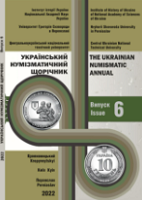СКАРБ КЕЛЬТСЬКИХ МОНЕТ З КОЛИШНЬОГО ВИНОГРАДІВСЬКОГО РАЙОНУ ЗАКАРПАТСЬКОЇ ОБЛАСТІ
THE HOARD OF CELTIC COINS FROM THE FORMER VYNOGRADIV DISTRICT OF TRANSCARPATHIAN REGION
Author(s): Mykhailo OrlykSubject(s): Archaeology, Cultural history, Regional Geography, Economic history, Ancient World
Published by: ДВНЗ Переяслав-Хмельницький державний педагогічний університет імені Григорія Сковороди
Keywords: hoard; coins; money; ancient economy; money issue; settlement; Geto-Dacians; Celts; Transcarpathia; Mala Kopania; Medieshul Aurit;
Summary/Abstract: The article analyses the hoard accumulated (thesaurus) in pottery ceramics which included more than 4000 coins of the Medieşul Aurit type and were found near the Mala Kopanya settlement in the former Vynogradiv district of Zakarpattia region (Transcarpathian region). Many tribes that did not belong to the Celtic group were under the assimilative influence of the last during the process of Celtic culture spreading to the East in the 3rd century BC. The representatives of the Costoboci culture belonging to the Thracian group were one of such tribes, that were significantly influenced by Celtic culture and were actually latenized. The scientists attribute the population of the Mala Kopanya hillfort to the Costoboci culture. The theoretical and methodological foundations of the research consist of a combination of general scientific historical and numismatic research methods. Scientific novelty. In general, ten hoards of coins of the Medieşul Aurit type in Eastern Europe are known to historical and archaeological science, the largest hoard of coins of this type was considered the hoard of 107 coins found in Romania in 1903. For the first time, it has been attempted to analyze in general terms the hoard, which included more than 4 thousand coins of the Medieşul Aurit type in the article. The author partially established the context of the find and determined the chronological boundaries of the accumulation of the hoard. This treasure reveals previously unknown aspects of money circulation on the territory of the Latenized Dacian tribes in the 1st century BC- 1st century AD. The main results of the study. What makes this hoard particularly interesting is not only the extremely large number of coins in the hoard, but also the chronological limits of the accumulation of the hoard, which were established with the help of typological analysis of the ceramics that were used to store the coins and XRF analysis of some coins from the hoard. The article focuses on significant inequality in the composition of the master alloys, which confirmed the long-time circulation of coins in the monetary system of this region. The author, considering the homogeneity of the coins and their number in the hoard, supports the hypothesis of E. Kolnikova and V. Kotygoroshko, that there was a center for minting coins of the Medieşul Aurit type in this region. The jug, in which the hoard was accumulated, was attributed by the author to the Pottery ceramics, which also indicates that the accumulation of the hoard took place no later than the 1st century and could be associated with hostilities or intertribal wars in the region. Based on the sum of factors, we can say that the most probable period of hoard accumulation is the beginning of the 1st century. The article focuses on the fact that this hoard stands out from the statistics of finds of such coins both on the territory of Ukraine and Romania, which can be an additional argument to confirm the hypothesis of a minting center in the area of the hillfort. It has been suggested that this hoard included the treasury of the hillfort, which was most likely hoarded due to an attack on the settlement of other Dacian tribes at the beginning of the 1st century.
Journal: Український Нумізматичний Щорічник
- Issue Year: 2022
- Issue No: 6
- Page Range: 109-123
- Page Count: 15
- Language: Ukrainian

